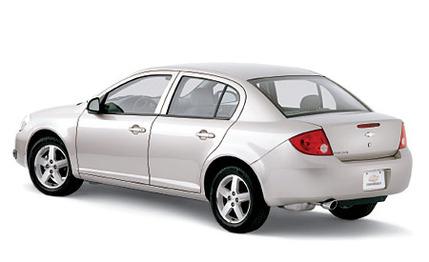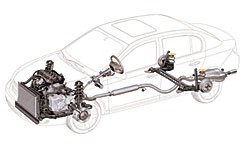 First Drive Review
First Drive Review
The aging Chevrolet Cavalier, born in 1982, will be replaced this November by the Cobalt, and Chevy has been so eager to tell us about this new line of front-drive coupes and sedans that it offered the following deal: If we'd hold off writing about our "driving impressions," we could have seat time in a few engineering mules and talk techno with key Cobalt engineers.
"Bring it on," we said, and checked in at GM's desert proving ground in Mesa, Arizona. The menu included two black 140-hp Cobalt sedans that were about 90 percent baked and a white 170-hp coupe that was more like 80 percent.
A little background: The Cobalt is built on GM's Delta platform, which was new with the Saturn Ion in 2003. Uh-oh! An early Ion proved to be amazingly durable in our 40,000-mile long-term test (March 2004). It was also a rackety little bastard of a four-door that our road-test editor passed around to staffers as penance for past offenses. The Cobalt has a lot to live down with us.
Now the post-drive synopsis: The Cobalt has been to charm school. That's a fact, not an impression, so we can blurt it right out.
When we mentioned our Ion misgivings to Doug Parks, Cobalt chief engineer, he groaned. He knew everything, because he's been 30 months on the job trying to fix all of those . . . well, GM cheaped out on its first Delta. You know the story. Cheap R Us has been GM's business plan since the Cavalier was young.
But no more, Parks and others assure us. He points to the comprehensive arrangement of seals around the Cobalt's doors. He nods toward a large and deeply sculpted plastic cover over the Ecotec four, backed by noise-eating foam. He tells of the laminated steel fire wall and cowl plenum, new since the Ion. He describes the special Cobalt tires that have just the right combination of stiffness in the sidewalls and damping in the tread to achieve sharp steering response and low noise. They cost 0.3 to 0.4 mpg of fuel in EPA mileage, but they please the driver.
Yeah, right. It's easy to dismiss this pre-preview tub thumping for what it is, GM's attempt to manage the news. Moreover, our record on these pronouncements has some dents. We were impressed by the Chevy Vega in a 1970 drive of engineering cars much like this Cobalt jaunt. You may even remember our 15-page hallelujah following the preview of the 1980 Chevy Citation, Pontiac Phoenix, etc., line of X-cars. Boy, did we do a butt plant on that prediction!
But things are different this time. (Yeah, right-Ed.) GM has an evangelist for good cars-Bob Lutz-and he has a vice-chairman's clout. In so many words, Parks says Lutz told engineers not to hold back on the good stuff and how they'll get that money back and more in reduced rebates.
Our noisy Ion didn't have the cast alloy oil pan that stiffens, and therefore quiets, the engine's structure. It didn't have the stiffened transmission attachment, either. Actually, the trans now bolts to the block and the pan. There's a low-noise tensioner for the cam-drive chain. Even the oil pump is being finessed to damp a pulsation in the bypass port. The list goes on.
Lutz says being competitive isn't enough. The Cobalt has to be better than competing small cars to get the market to notice.
Things are different now in another way. Chevrolet is no longer trying to cover the whole bottom of the market with one model. It has the Korean-made Aveo to serve up low, low prices, allowing the Cobalt to move up to the cream of the skinflints.
They get a package that's big for the class at 180.3 inches overall for the four-door, about halfway between the shorter Toyota Corolla and the longer Cavalier. The exterior is a yawner, one more "universal small sedan," but the interior is a mini-Lexus in its shapes, tones, and textures. Chrome touches are back, in the bezels and door handles.
The looker of the family is the coupe, with its smartly curved rear glass and cute butt punctuated by four round taillights. The standard engine for both is a 140-hp, 2.2-liter Ecotec four. Opting for the SS version gets a bored-and-stroked Ecotec with variable cam timing, giving 170 horses from 2.4 liters. It would have been cheaper to use the same balance shafts in both engines, at a small sacrifice in smoothness. But, no, that's not the Lutz way.

There will be an SS Supercharged coupe, too, with an intercooled huffer on a 2.0-liter engine promising 205 horsepower at 5600 rpm.
So we're cautiously optimistic. The rear suspension is a trailing-arm arrangement braced by a twist beam, similar to what VW has been using in small cars since the '70s Rabbit. Parks told us of his mission to discover why his guys couldn't match VW's way of "enveloping the bumps." Finally, they found the secret by cutting apart a Jetta's trailing-arm bushings. They're exotic fluid-filled, two-chamber hydraulic dampers. And they're expensive! GM bean counters would never okay the cost. Everybody knew that.
But this is the Lutz era, and the Cobalt will have the magic bushings. Could that luckless Ion have been GM's low point?